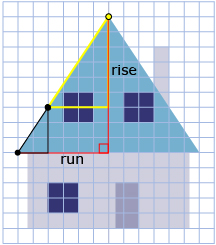Section 1
1. Section 1
1.17. Explore 2
Section 1: Slope—Physical Objects
Self-Check 1

- Calculate the slope between two different places on the diagram above.
- How do the two slopes on the same line compare? Answer
Refer back to Discover. What patterns did you discover for the slope of lines? You may have noticed that the slope of a curved line changed. The slope on the curved line depended on where you measured the rise and run on the curve. This slope was very different than the slope of a straight line. The slope of a straight line is the same no matter where you measure the rise and run. This slope is called a constant slope.
A straight line has a constant slope. A curved line does not.

Self-Check 2
Answer true or false to questions 1 and 2.
- Line segment PS would have a constant slope. Answer
- Line segments PQ, QR, and PR would have different slopes. Answer
- Calculate the slope of PS. How did you calculate the slope? Answer